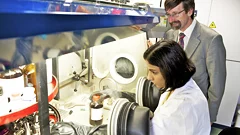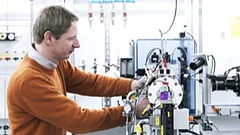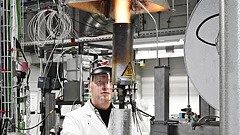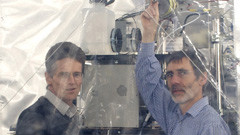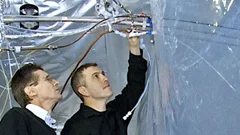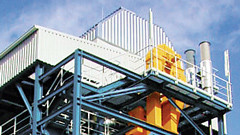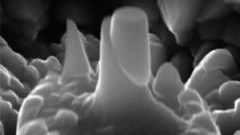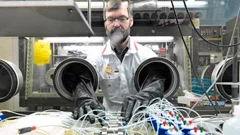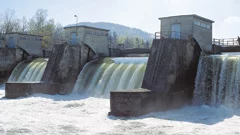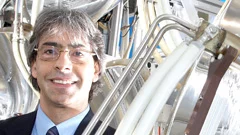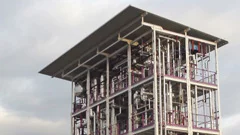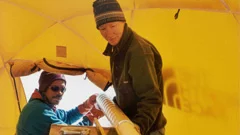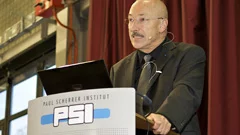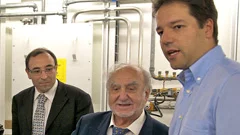Energy and Climate
The energy research performed at PSI focuses on processes that can be used in sustainable and safer technologies, ideally with minimal CO2 emissions. The main emphasis is on renewable energy sources. The ESI (Energy System Integration) platform enables research and industry to test solutions for integrating renewables into the existing energy supply. Another focus in this area is the safer use of nuclear energy. These activities are supplemented by analyses giving a comprehensive assessment of energy systems. PSI scientists in the Energy and Environment division study the chemical processes that take place in the atmosphere.
Find out more at: Overview Energy and Climate
Gemeinsam forschen für bessere Batterien
Die Speicherung von elektrischer Energie ist eine der zentralen Fragen der Energiezukunft. Neue Batterietypen zu entwickeln, die mehr Energie speichern können als die heute verfügbaren, ist das Ziel eines Forschungsnetzwerks, das der weltweit grösste Chemiekonzern BASF gemeinsam mit dem Paul Scherrer Institut PSI und Forschungseinrichtungen aus Deutschland und Israel gegründet hat.This news release is only available in German.
Swiss Energy Research in the European Alliance
Paul Scherrer Institute takes part in European Energy Research AllianceThe development of pathways towards a sustainable energy supply is one of the most urgent technical challenges facing us today. The Paul Scherrer Institute (PSI) has, for many years, made important scientific contributions to new energy technologies.
Lösungsansätze zum Schutz des globalen Klimas
Tagung am Paul Scherrer Institut bringt Energiefachleute zusammenAls grösstes Energieforschungszentrum der Schweiz und Sitz des Kompetenzzentrum Energie und Mobilität CCEM lud das Paul Scherrer Institut am 11. Juni zu einer Tagung über Lösungsansätze zum Schutz des globalen Klimas ein. Acht Vorträge von Energieexperten aus Forschung und Industrie zeigten die Vielfalt der Verfahren, die zu einer Reduzierung des CO2-Ausstosses führen könnten. In der anschliessenden Podiumsdiskussion wurde deutlich, was über technische Ansätze hinaus getan werden muss.This news release is only available in German.
The mass concentration of volcanic ash from Iceland in European airspace
Data of the Paul Scherrer Institute from the High-Alpine Research Station Jungfraujoch yield important information.The eruption of the volcano Eyjafjallajokull in Iceland has stalled flight traffic in large parts of Europe. Decision makers had to base their decisions mainly on model calculations for the volcanic plume dispersion. How dangerous is this volcanic ash layer for planes?
News from the smog chamber: mechanisms of particle formation in the atmosphere unveiled
Up to the present time, the nucleation or new formation of particles in the atmosphere has been a great enigma. Until recently, research was based on the assumption that sulphuric acid played the central role in particle formation. However, laboratory experiments and field tests have consistently provided conflicting results. In the lab, considerably higher concentrations of sulphuric acid are required for nucleation to take place than in the atmosphere itself. Now scientists from the Paul Scherrer Institute (PSI) have found out the cause for these conflicting results from their smog chamber. These findings will advance climate research to a significant degree.
Mystery solved: how fine particulates are formed in the air
Researchers from the Paul Scherrer Institute, the University of Colorado and 29 other research institutions in various countries have investigated the composition of the organic constituents of the fine particulates found in various regions of the world, and have identified the original substances from which they are formed in each case. For the first time ever, this has enabled them to explain the role played by the individual components of emissions in the development of fine particulates.
Producing Synthetic Natural Gas from Wood
PSI researchers are investigating methods for converting wood waste into synthetic natural gas that could be fed into the public gas grid. Switzerland has enough wood available to cover several percent of its total energy requirements. Energy production from wood is CO2-neutral, due to the fact the CO2 formed during combustion would otherwise be released when the wood rotted down. Unlike the direct combustion of wood, however, use of this synthetic gas produces no harmful particulate matter.
Reliable materials for nuclear reactors
Materials used in nuclear power plants are subjected to extreme conditions. The safety standards for the selection, deployment and monitoring of these materials are extremely high. At PSI, the long-term behaviour of power plant components is being studied. Hence researchers investigate the impact of stress-corrosion cracking in materials, or the effects of strong radioactive radiation on their durability.
Safe repositories for radioactive waste - a study of specifically Swiss conditions
Radioactive waste from nuclear power plants, as well as from medical applications, industry and research, has to be isolated from the environment, particularly the habitat of humans, for a very long time. Specialists at PSI have been concerned with the safety issues surrounding safety certification for geological repositories for many years. Research at PSI focusses primarily on the physico-chemical processes inside such storage systems. The aim is to create a realistic description of the risks associated with storage of radioactive waste.
Structures and impacts of national and international energy systems – national climatic targets for Switzerland
The Paul Scherrer Institut analyses the structures and impacts of national and international energy systems. In 2007, for example, a study was carried out in which PSI makes recommendations as to what the national climatic targets of Switzerland could be. The study also highlighted the facts on which the Swiss energy system is based and indicated which targets can be achieved and how. Protection of the climate is, after all, one of the most important areas of national energy policy for the coming years, and the emission of CO2 in Switzerland should be at least halved by the year 2050. Better energy efficiency is an important factor towards this goal – but not the only one.
Frozen memory of the climate
Information about the climate and atmospheric composition in previous centuries can be stored in glacier ice. PSI-researchers undertake regular expeditions to various areas within these regions to remove ice cores. These ice cores are effectively solid columns of ice that have been drilled out from a glacier. Once in the laboratory, the cores are thawed out and their composition is analysed, layer by layer. The results provide fascinating insights into a range of aspects of the previous climate.
Treibstoff aus Sonnenenergie
Solar researcher Aldo Steinfeld, Laboratory Head at PSI and Professor at ETH Zurich, wins the Yellot Award awarded by the American Society of Mechanical Engineers (ASME) for his research on renewable energy.This news release is only available in German.
In Zukunft kommt das Brennholz aus der Gasleitung
Forschende des Paul Scherrer Instituts (PSI) haben mit Kollegen der TU Wien ein Verfahren entwickelt, mit dem man Erdgas aus Holz erzeugen kann. An einer Testanlage wurde das Verfahren im technischen Massstab erfolgreich erprobt. Für Ihre Arbeit erhalten die PSI-Forschenden am 8. Januar die Auszeichnung Watt d'Or.This news release is only available in French and German.
Temperature response in the Altai lags solar forcing
Publication in Geophysical Research Letters. New results from climate research using ice cores from the Siberian Altai. The observation that the reconstructed temperatures followed the solar forcing with a delay of 10 to 30 years is particularly interesting.
Saubere Dieselverbrennung für sauberere Meeresluft
Gemeinsam mit der Industrie forscht man am Paul Scherrer Institut an neuen Schiffsmotoren. Was bei Dieselfahrzeugen zu Land schon lange die Norm ist, soll nun auch auf den Meeren umgesetzt werden: Nicht nur Lastwagen und Dieselautos fahren stickoxidreduziert, sondern auch Schiffe. Während dieses Ergebnis bei Fahrzeugen hauptsächlich durch den Einbau von Katalysatoren erreicht wird, ist das Ziel bei Schiffen eine innermotorische Lösung.This news release is only available in German.
Die Belenos Clean Power AG und das Paul Scherrer Institut beschliessen die Schweizer Brennstoffzelle
Die Vision geht in die operative Phase. Ein nachhaltiger, sauberer Energieverbrauch und eine individuelle Mobilität mit sauberer, CO2-freier Energie, das ist die Vision der Belenos Clean Power AG. Um dieses Ziel zu erreichen, müssen Anstrengungen unternommen werden, die die ganze Kette von der nachhaltigen Primärenergie à der Sonne à über die saubere Energie für Haushalte, Fabriken u. ä., bis zum effizienten, emissionsfreien Auto-Antrieb umfassen.This news release is only available in French and German.
